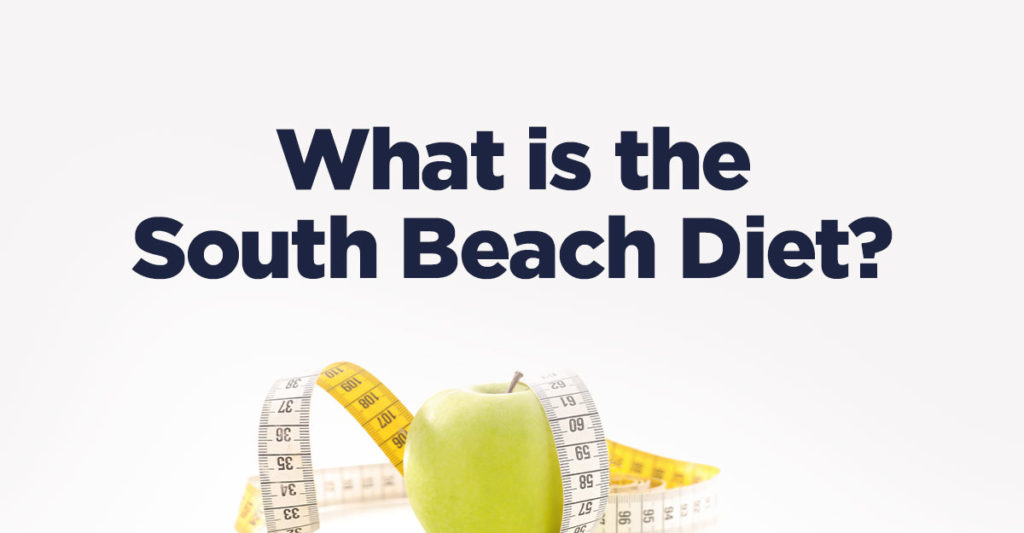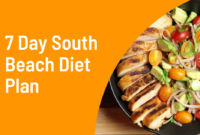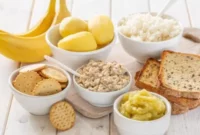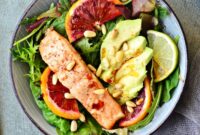How does the South Beach Diet work? This popular weight-loss plan distinguishes itself through a phased approach, focusing on controlled carbohydrate intake and prioritizing healthy fats and lean proteins. Unlike restrictive diets that eliminate entire food groups, the South Beach Diet emphasizes gradual changes, making it potentially more sustainable for long-term weight management. Understanding its three phases, macronutrient balance, and the role of glycemic index is key to unlocking its effectiveness and potential benefits.
The diet’s initial phase involves a strict limitation on certain carbohydrates to curb insulin spikes and promote fat burning. Subsequent phases gradually reintroduce more carbohydrates, focusing on those with a lower glycemic index. This measured approach aims to minimize cravings and prevent the metabolic slowdown often associated with rapid weight loss. The South Beach Diet also highlights the importance of incorporating healthy fats and lean proteins for satiety and overall health, promoting a balanced and sustainable eating pattern.
The Core Principles of the South Beach Diet
The South Beach Diet is a low-carbohydrate diet that emphasizes healthy fats and lean proteins while limiting processed foods and sugary drinks. Unlike some restrictive diets, it focuses on sustainable lifestyle changes rather than rapid weight loss, making it potentially easier to maintain long-term. The diet is structured into three phases, each with progressively fewer restrictions.
The Three Phases of the South Beach Diet
The South Beach Diet’s effectiveness stems from its phased approach. This allows for initial rapid weight loss while establishing healthy eating habits for long-term success. Each phase focuses on different food groups and restrictions to achieve specific goals.
Phase 1: The Initial Phase (Weeks 1-2)
This phase is the most restrictive, aiming for rapid weight loss by eliminating simple carbohydrates and unhealthy fats. The goal is to kickstart weight loss and reduce cravings.
Permitted Food Groups:
Lean proteins (fish, poultry, beans, tofu), healthy fats (olive oil, avocados, nuts), non-starchy vegetables (leafy greens, broccoli, peppers), and limited amounts of whole grains (in moderation).
Restricted Food Groups:
Sugary drinks, sweets, processed foods, white bread, pasta, rice, and most fruits (except berries in limited quantities).
Sample Meal Plan (Phase 1):
| Breakfast | Lunch | Dinner | Snacks |
|---|---|---|---|
| Scrambled eggs with spinach and a small avocado | Grilled chicken salad with mixed greens and olive oil dressing | Baked salmon with roasted asparagus | Handful of almonds |
Phase 2: The Weight Loss Phase (Weeks 3-Onward)
Once initial weight loss is achieved, Phase 2 introduces more food choices while maintaining healthy eating habits. The goal is to continue weight loss at a steady pace.
Permitted Food Groups:
All foods permitted in Phase 1, plus some fruits (apples, oranges, pears), and whole grains (in moderation). Higher carbohydrate foods are reintroduced gradually.
Restricted Food Groups:
Sugary drinks, sweets, processed foods, and foods high in unhealthy fats remain restricted.
Sample Meal Plan (Phase 2):
| Breakfast | Lunch | Dinner | Snacks |
|---|---|---|---|
| Oatmeal with berries and nuts | Turkey breast sandwich on whole-wheat bread with lettuce and tomato | Chicken stir-fry with brown rice and plenty of vegetables | Greek yogurt with berries |
Phase 3: The Lifetime Maintenance Phase
This phase focuses on maintaining a healthy weight and lifestyle. It involves incorporating a wider variety of foods while maintaining mindful eating habits.
Permitted Food Groups:
Most foods are permitted in moderation, including occasional treats. The emphasis remains on whole, unprocessed foods and portion control.
Restricted Food Groups:
Highly processed foods, sugary drinks, and excessive amounts of unhealthy fats should still be limited.
Sample Meal Plan (Phase 3):
| Breakfast | Lunch | Dinner | Snacks |
|---|---|---|---|
| Whole-wheat toast with avocado and a poached egg | Leftovers from dinner | Lean beef with sweet potato and green beans | A small piece of dark chocolate |
Nutritional Aspects of the South Beach Diet
The South Beach Diet distinguishes itself through its carefully planned approach to macronutrient ratios and its emphasis on the glycemic index and load. Unlike many restrictive diets, it doesn’t simply cut calories; it focuses on the *quality* of those calories and their impact on blood sugar levels. This nuanced approach aims for sustainable weight loss and improved metabolic health.
The diet is divided into three phases, each with a slightly different macronutrient emphasis. This phased approach allows for gradual changes in eating habits, making it more manageable for long-term adherence.
Macronutrient Ratios in Each Phase
The South Beach Diet carefully balances macronutrients across its phases. Phase 1, the most restrictive, emphasizes a lower carbohydrate intake to control blood sugar spikes and promote initial weight loss. As the dieter progresses through phases 2 and 3, the carbohydrate allowance gradually increases, allowing for a more varied and sustainable diet. Protein intake remains relatively consistent throughout, supporting satiety and muscle mass preservation. Healthy fats are encouraged throughout all phases, providing essential fatty acids and contributing to feelings of fullness. Precise ratios vary depending on individual caloric needs and goals, but the general trend is a shift from low-carb in Phase 1 to a more moderate carbohydrate intake in later phases.
The Role of Glycemic Index and Glycemic Load
The South Beach Diet’s success hinges on its careful selection of foods based on their glycemic index (GI) and glycemic load (GL). The GI measures how quickly a carbohydrate-containing food raises blood sugar levels. The GL considers both the GI and the amount of carbohydrates in a serving. The diet prioritizes low-GI and low-GL foods, minimizing blood sugar spikes and insulin surges that can contribute to weight gain and metabolic issues. This approach helps to regulate appetite and prevent energy crashes. By focusing on foods with a lower impact on blood sugar, the diet aims to promote sustained energy levels and reduce cravings.
Examples of Healthy Fats and Carbohydrates
Understanding which fats and carbohydrates are permissible is crucial for successful adherence to the South Beach Diet.
The diet emphasizes healthy fats that provide essential nutrients and promote satiety.
- Healthy Fats: Avocados, nuts (almonds, walnuts, pecans), olive oil, fatty fish (salmon, tuna, mackerel), and flaxseeds.
The diet carefully selects carbohydrates based on their GI and GL values, favoring those that are slowly digested and absorbed.
- Healthy Carbohydrates: Whole grains (such as quinoa and brown rice in later phases), legumes (beans, lentils), non-starchy vegetables (broccoli, spinach, asparagus, peppers), and fruits (berries, apples, pears – in moderation).
The South Beach Diet and Weight Loss
The South Beach Diet’s effectiveness in promoting weight loss stems from its structured approach to carbohydrate intake and its emphasis on nutrient-rich foods. Unlike many restrictive diets, it doesn’t completely eliminate entire food groups, instead focusing on phasing in different types of carbohydrates based on their glycemic index. This gradual approach aims to stabilize blood sugar levels, reduce cravings, and promote sustainable weight management.
The diet achieves weight loss primarily through a calorie deficit, achieved by limiting refined carbohydrates and encouraging the consumption of lean proteins, healthy fats, and non-starchy vegetables. The initial phase restricts high-glycemic carbohydrates, leading to a rapid initial weight loss due to water loss and reduced carbohydrate storage. Subsequent phases gradually reintroduce more carbohydrates, focusing on those with a lower glycemic index, which are digested and absorbed more slowly, leading to more stable blood sugar and energy levels. This process supports long-term weight maintenance.
Comparison with Other Diets
The South Beach Diet differs from other popular weight-loss approaches in its approach to carbohydrates. A comparison with the Ketogenic and Mediterranean diets highlights these differences:
| Feature | South Beach Diet | Ketogenic Diet | Mediterranean Diet |
|---|---|---|---|
| Carbohydrate Intake | Gradual reintroduction of low-glycemic carbohydrates | Very low carbohydrate intake (<50g/day) | Moderate carbohydrate intake, primarily from fruits, vegetables, and whole grains |
| Fat Intake | Moderate fat intake, emphasizing healthy fats | High fat intake (70-80% of calories) | Moderate fat intake, emphasizing monounsaturated fats |
| Protein Intake | Moderate protein intake | Moderate protein intake | Moderate protein intake |
| Weight Loss Mechanism | Calorie deficit, blood sugar stabilization | Ketosis (burning fat for energy) | Calorie deficit, balanced nutrition |
| Sustainability | Generally considered more sustainable due to less restrictive nature | Can be difficult to maintain long-term due to restrictive nature | Generally considered sustainable due to flexibility and emphasis on whole foods |
Potential Challenges and Pitfalls
While the South Beach Diet offers a structured approach to weight loss, individuals may encounter several challenges. Strict adherence to the initial phase’s restrictions can be difficult for some, leading to feelings of deprivation. The detailed meal planning required can be time-consuming, and the cost of certain ingredients may be higher than those found in less restrictive diets. Social situations involving food may also pose challenges, requiring careful planning and mindful choices. Furthermore, without consistent monitoring and adjustments, weight loss may plateau, necessitating a reassessment of the dietary approach. Finally, individual metabolic responses vary, and some individuals may not experience the same level of success as others. For example, someone with a pre-existing medical condition might find it difficult to manage the diet without consulting their doctor.
Health Implications and Considerations
The South Beach Diet, while potentially beneficial for weight loss and certain health markers, presents both advantages and disadvantages that warrant careful consideration. Understanding these implications allows individuals to make informed decisions about whether this dietary approach aligns with their specific health needs and goals. It’s crucial to remember that individual responses to any diet can vary significantly.
Potential Health Benefits of the South Beach Diet
The South Beach Diet’s emphasis on limiting refined carbohydrates and prioritizing healthy fats and lean proteins can lead to several positive health outcomes. Improved blood sugar control is a frequently cited benefit, particularly for individuals with insulin resistance or type 2 diabetes. By minimizing blood sugar spikes, the diet may contribute to better overall metabolic health. Furthermore, the focus on nutrient-rich foods can reduce inflammation throughout the body, potentially lessening the risk of chronic diseases associated with inflammation, such as heart disease and certain cancers. The high protein content can also aid in satiety, reducing overall calorie intake and contributing to weight management.
Potential Risks and Side Effects
While the South Beach Diet offers potential benefits, it also carries the risk of certain side effects and nutrient deficiencies if not carefully managed. The restrictive nature of the initial phases, particularly the elimination of many fruits and certain vegetables, can lead to digestive issues like constipation or diarrhea in some individuals. Furthermore, the emphasis on certain food groups while restricting others can create imbalances in nutrient intake, potentially leading to deficiencies if not carefully monitored. The rapid weight loss experienced by some individuals can also have negative consequences, such as muscle loss and metabolic slowing. Headaches, fatigue, and irritability are also commonly reported side effects, often associated with the initial carbohydrate restriction. It’s important to consult with a healthcare professional or registered dietitian before starting the South Beach Diet, particularly if you have pre-existing health conditions.
Potential Nutrient Deficiencies and Mitigation Strategies
The following table outlines potential nutrient deficiencies associated with the South Beach Diet and strategies to mitigate these risks. It is crucial to remember that these are potential risks, and not every individual will experience them. Individual needs vary, and consulting a registered dietitian is recommended for personalized dietary advice.
| Potential Nutrient Deficiency | Reason for Deficiency | Mitigation Strategies |
|---|---|---|
| Fiber | Restriction of certain fruits and vegetables in the initial phases. | Include high-fiber options like whole grains (once introduced), legumes, and plenty of non-starchy vegetables throughout the diet. Consider a fiber supplement if needed, after consulting a doctor. |
| Certain Vitamins and Minerals | Limited variety of fruits and vegetables in early phases. | Gradually increase the variety of fruits and vegetables as the diet progresses. Consider a multivitamin after consulting with a doctor or registered dietitian. |
| Magnesium | Restricted intake of whole grains and some vegetables. | Increase intake of magnesium-rich foods like leafy green vegetables, nuts, and seeds, once introduced in later phases. A doctor or registered dietitian can advise on magnesium supplementation if necessary. |
Final Thoughts
In conclusion, the South Beach Diet offers a structured approach to weight loss, emphasizing gradual changes and a balanced intake of macronutrients. While it shares similarities with other diets, its phased approach and focus on healthy fats and specific carbohydrates set it apart. By understanding the principles behind each phase and prioritizing long-term lifestyle changes, individuals can potentially achieve sustainable weight loss and improve overall health. However, individual results may vary, and consulting a healthcare professional before starting any new diet is always recommended.




